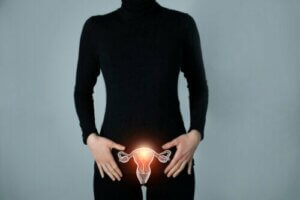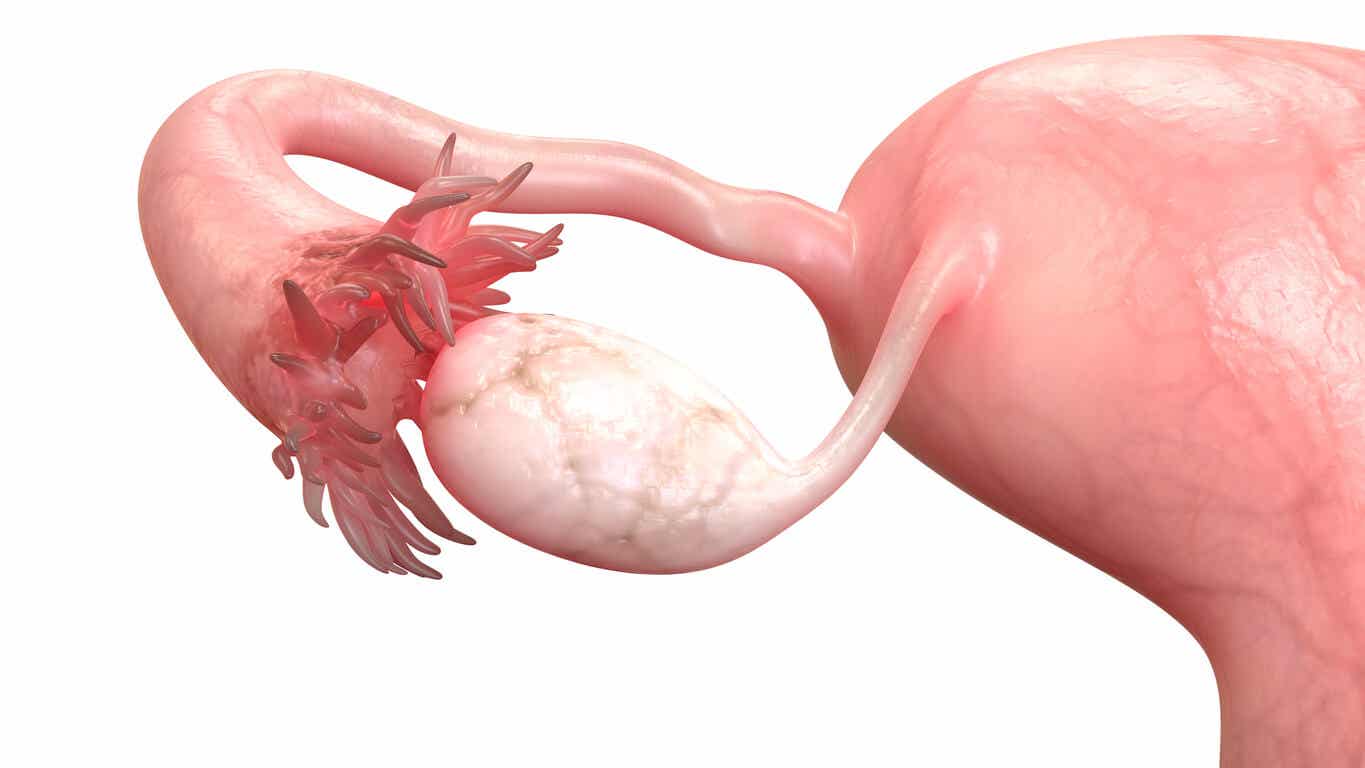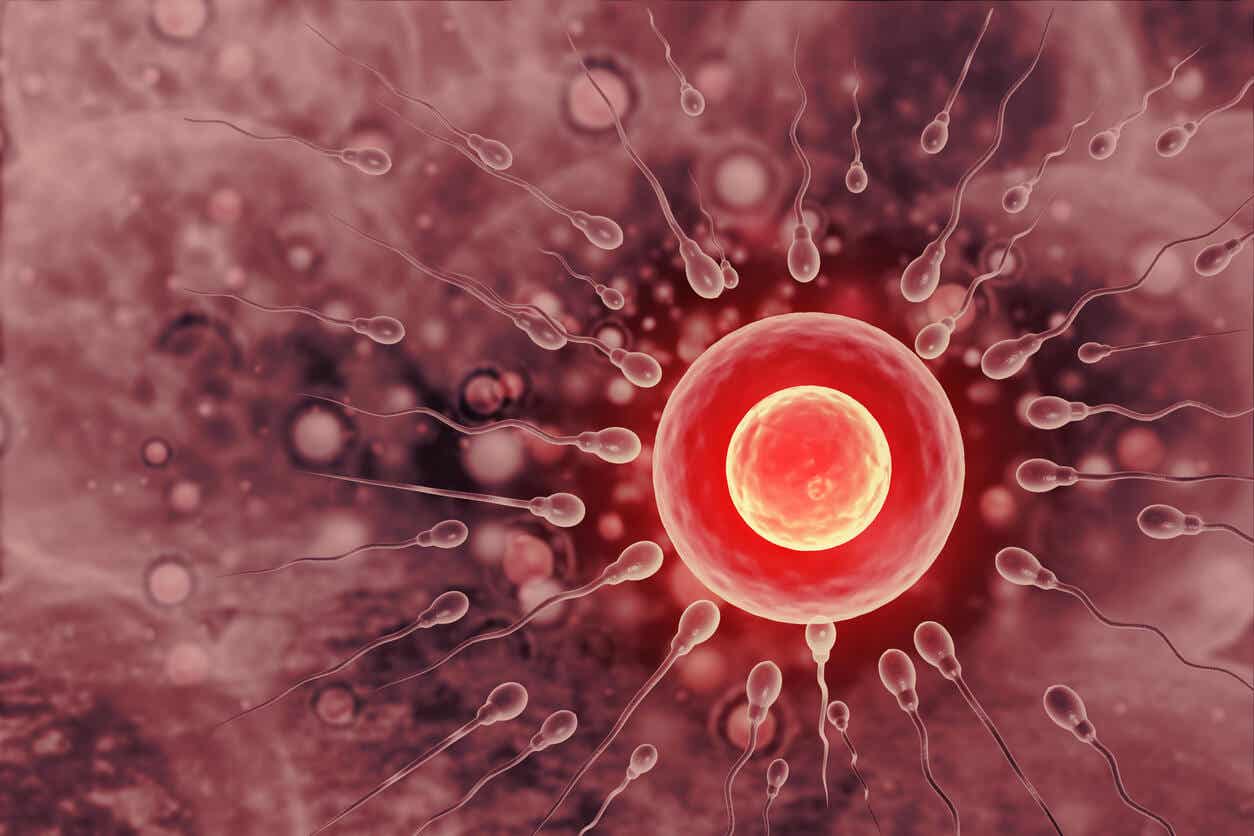What Are the Fallopian Tubes?

The fallopian tubes are a pair of elongated organs, located on each side of the uterus and in close contact with the ovaries. Being part of the reproductive system, they play a fundamental role in the transportation of eggs and sperm. In fact, fertilization occurs in one of their segments.
If you’re interested in knowing a little more about their structure, functioning, and the diseases in which they may be involved, we invite you to read the following article.
Anatomy
The fallopian tubes are elongated, tubular organs measuring an average of 4 inches. For practical purposes, it’s possible to distinguish several portions or segments:

- Infundibulum: This is the outermost or distal portion, which is in contact with the ovaries. It’s characterized by several prolongations called fimbriae.
- Ampulla: As its name suggests, it’s a widened portion. Because of its shape, it facilitates the encounter between the ovum and the spermatozoon, that is, fertilization.
- Isthmus: Unlike the ampulla, the isthmus tends to be smaller and longer, facilitating the path of the ovum to the interior of the uterus.
- Interstitial: This is a small area with particular microscopic characteristics, which allows the union between the womb (the uterus) and the tubes.
If you were to analyze the tissue with a microscope, you would observe numerous elongated structures–plicae–, which are constantly moving, favoring the path of the egg along the tubes towards the uterus.
Find out more: 4 Interesting Facts About Ovules
Functions
The main function of the uterine tubes is to serve as a means of transporting the egg to facilitate its encounter with the sperm. To understand the process, it’s important to take into account the anatomical structures we mentioned above.
Before ovulation
We refer to ovulation as the process through which an ovarian follicle releases an oocyte (the immature form of the egg). Like all the changes that occur during the menstrual cycle, this also occurs as a result of hormonal changes.
These hormones induce changes in the internal structure of the uterine tubes, resulting in an increase in the size of both the fimbriae and the plicae. In the first case, to facilitate the “capture” of the oocyte once it’s released. And, in the case of the plicae, to allow mobilization toward the ampulla.
During ovulation
The contractions of the muscles present in the fallopian tubes, the movement of the internal villi, and the secretions released inside this structure favor the movement of the future ovum along the uterine tubes.
If the woman had sexual intercourse in the hours prior to ovulation, this will favor the movement of the sperm by the same structures, but in the opposite direction. That is, from the uterine womb to the ampulla.
Find out more: Sperm’s Fight for Survival
After ovulation
In the event of fertilization of the ovum, the future embryo will travel by the same mechanisms towards the uterine womb where it will adhere to one of its walls. Here, it will begin the process of cell division necessary for the growth and development of the baby.
However, if fertilization doesn’t occur, the uterus will absorb the egg and menstrual bleeding will occur. Menstrual bleeding is nothing more than the shedding of the endometrium, the innermost layer of the uterus.

Diseases that can affect the fallopian tubes
Multiple events can lead to inflammation or damage of the uterine tubes. The MSD Manual summarizes some of them, and we’ll explain them below:
- Pelvic inflammatory disease. This is usually the result of a sexually transmitted infection, such as gonorrhea or chlamydia. It involves severe pelvic pain, fever, and foul-smelling vaginal discharge, among others.
- Ectopic pregnancy. Occasionally, fertilization or the transport of the fertilized oocyte occurs abnormally. This results in the development of the pregnancy in a site other than the endometrium, a condition that endangers the mother’s life and is incompatible with the proper development of the baby.
- Endometriosis. This is the presence of endometrial tissue in an abnormal area, for example, in the uterine tubes. This results in the development of scar tissue or cysts.
Some final considerations about the Fallopian Tubes
The fallopian tubes are essential in order to ensure reproduction in humans. Despite their small size, they allow sperm and egg to meet by facilitating transport along the reproductive tract. Without them, life as we know it couldn’t exist.
The fallopian tubes are a pair of elongated organs, located on each side of the uterus and in close contact with the ovaries. Being part of the reproductive system, they play a fundamental role in the transportation of eggs and sperm. In fact, fertilization occurs in one of their segments.
If you’re interested in knowing a little more about their structure, functioning, and the diseases in which they may be involved, we invite you to read the following article.
Anatomy
The fallopian tubes are elongated, tubular organs measuring an average of 4 inches. For practical purposes, it’s possible to distinguish several portions or segments:

- Infundibulum: This is the outermost or distal portion, which is in contact with the ovaries. It’s characterized by several prolongations called fimbriae.
- Ampulla: As its name suggests, it’s a widened portion. Because of its shape, it facilitates the encounter between the ovum and the spermatozoon, that is, fertilization.
- Isthmus: Unlike the ampulla, the isthmus tends to be smaller and longer, facilitating the path of the ovum to the interior of the uterus.
- Interstitial: This is a small area with particular microscopic characteristics, which allows the union between the womb (the uterus) and the tubes.
If you were to analyze the tissue with a microscope, you would observe numerous elongated structures–plicae–, which are constantly moving, favoring the path of the egg along the tubes towards the uterus.
Find out more: 4 Interesting Facts About Ovules
Functions
The main function of the uterine tubes is to serve as a means of transporting the egg to facilitate its encounter with the sperm. To understand the process, it’s important to take into account the anatomical structures we mentioned above.
Before ovulation
We refer to ovulation as the process through which an ovarian follicle releases an oocyte (the immature form of the egg). Like all the changes that occur during the menstrual cycle, this also occurs as a result of hormonal changes.
These hormones induce changes in the internal structure of the uterine tubes, resulting in an increase in the size of both the fimbriae and the plicae. In the first case, to facilitate the “capture” of the oocyte once it’s released. And, in the case of the plicae, to allow mobilization toward the ampulla.
During ovulation
The contractions of the muscles present in the fallopian tubes, the movement of the internal villi, and the secretions released inside this structure favor the movement of the future ovum along the uterine tubes.
If the woman had sexual intercourse in the hours prior to ovulation, this will favor the movement of the sperm by the same structures, but in the opposite direction. That is, from the uterine womb to the ampulla.
Find out more: Sperm’s Fight for Survival
After ovulation
In the event of fertilization of the ovum, the future embryo will travel by the same mechanisms towards the uterine womb where it will adhere to one of its walls. Here, it will begin the process of cell division necessary for the growth and development of the baby.
However, if fertilization doesn’t occur, the uterus will absorb the egg and menstrual bleeding will occur. Menstrual bleeding is nothing more than the shedding of the endometrium, the innermost layer of the uterus.

Diseases that can affect the fallopian tubes
Multiple events can lead to inflammation or damage of the uterine tubes. The MSD Manual summarizes some of them, and we’ll explain them below:
- Pelvic inflammatory disease. This is usually the result of a sexually transmitted infection, such as gonorrhea or chlamydia. It involves severe pelvic pain, fever, and foul-smelling vaginal discharge, among others.
- Ectopic pregnancy. Occasionally, fertilization or the transport of the fertilized oocyte occurs abnormally. This results in the development of the pregnancy in a site other than the endometrium, a condition that endangers the mother’s life and is incompatible with the proper development of the baby.
- Endometriosis. This is the presence of endometrial tissue in an abnormal area, for example, in the uterine tubes. This results in the development of scar tissue or cysts.
Some final considerations about the Fallopian Tubes
The fallopian tubes are essential in order to ensure reproduction in humans. Despite their small size, they allow sperm and egg to meet by facilitating transport along the reproductive tract. Without them, life as we know it couldn’t exist.
All cited sources were thoroughly reviewed by our team to ensure their quality, reliability, currency, and validity. The bibliography of this article was considered reliable and of academic or scientific accuracy.
- Clínica Mayo. Endometriosis. Disponible en: https://www.mayoclinic.org/es-es/diseases-conditions/endometriosis/symptoms-causes/syc-20354656#:~:text=La%20endometriosis%20se%20produce%20cuando,normal%20durante%20el%20ciclo%20menstrual.
- Medline Plus. Enfermedad inflamatoria pélvica. Disponible en: https://medlineplus.gov/spanish/pelvicinflammatorydisease.html.
- Rebar R. Problemas en las trompas de Falopio y anomalías en la pelvis. Manual MSD. Disponible en: https://www.msdmanuals.com/es-ve/hogar/salud-femenina/infertilidad/problemas-en-las-trompas-de-falopio-y-anomal%C3%ADas-de-la-pelvis.
This text is provided for informational purposes only and does not replace consultation with a professional. If in doubt, consult your specialist.








